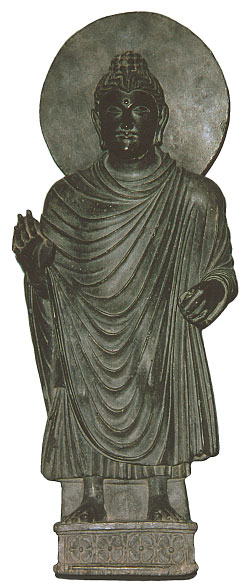Greco-Roman Influence in Buddhist Art
The influence of Greco-Roman art is still present in Western art. What examples of Greco-Roman influence can you think of in the art of other parts of the world? And why do you think the influence is still so strong in Western art appreciation?
 |
| India (Gandhara), Standing Buddha, 2nd-3rd century CE (Kushan Period). Phyllite, 23 1/4" x 13" (59.1 x 33 cm). Asian Art Museum of San Francisco, the Avery Brundage Collection, B60 S123+. |
This is my favorite image in our new edition of A Global Pursuit.
DID YOU KNOW that Alexander the Great conquered lands in central Asia that bordered northern India in 327 BCE? He was trying to wipe out all traces of the Persian Empire. During the time of the Roman Empire (flourished 27 BCE–ca. 453 CE), these lands became Roman colonies that sat on the western end of the Silk Road to China. An early Indian dynasty, the Kushan (flourished ca. 50–320 CE) of northern India, traded with Roman colonies. This led to the spread of the Roman version of the classical sculptural style into Asia. The historical dates for the Buddha are ca. 563–483 BCE. The very first images of the Buddha were produced during the 100s CE, and they show strong influences of classical sculpture, presumably based on images of Apollo.
Connections Across Curriculum: The Greco-Roman influence shows students that no culture exists in a vacuum. Art and culture passed down through the “Western Tradition” made its way east as well. Eastern technology that traveled along the Silk Road had a major impact on Western history in the form of printing methods, navigation technology, and gun powder.


Comments